Figure 1.
Transporters involved in K+ uptake by roots and inter-organ partition. HAK5, AKT1, and non-selective cyclic nucleotide-gated cation channels (CNGC) all contribute to K+ nutrition, albeit at different ranges of substrate concentrations, from low- to high-availability, respectively. K+ efflux through the outward-rectifying GORK channel facilitates the fine-tuning of plasma membrane electrical potential, and allows repolarization under circumstances that promote depolarization, such as salinity stress. In the root stele, the outward-rectifying SKOR channel releases K+ into the xylem vessels for nutrient delivery to the shoots. The nitrate transporter NRT1.5 facilitates K+ uploading into the xylem either by electrical coupling with other K+-selective transporters or directly acting as K+/H+ antiporter. In aerial tissues, an array of K+-influx channels and KT/HAK/KUP carriers allow the uptake of the incoming K+ into green cells. K+ is stored inside vacuoles by NHX exchangers and released back to the cytosol by TPK and TPC1 channels, and possibly also by KT/HAK/KUP carriers at the tonoplast (the vacuole in root cells is omitted for simplicity). The plasma membrane outward K+ channel AKT2 releases K+ into the phloem for returning K+ to the root and to facilitate the uploading of photosynthates into the phloem sap.

